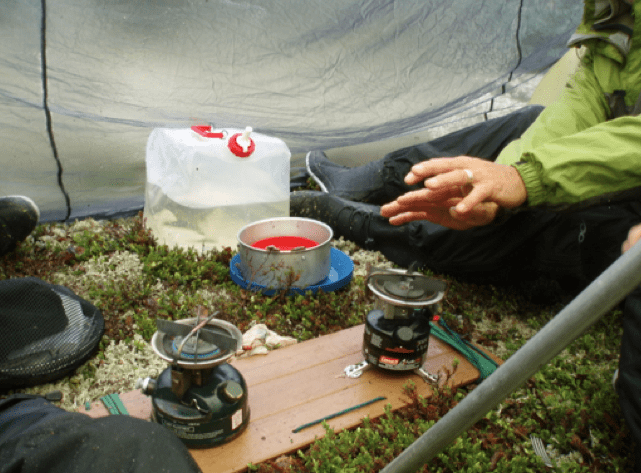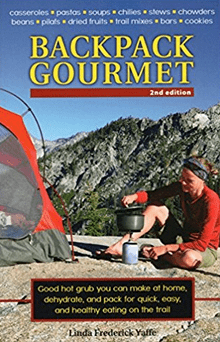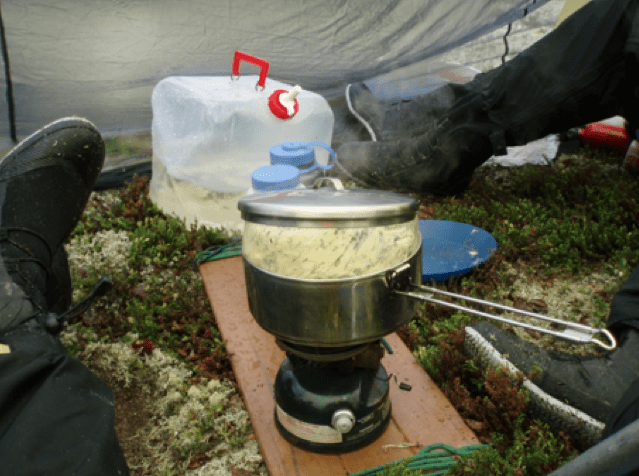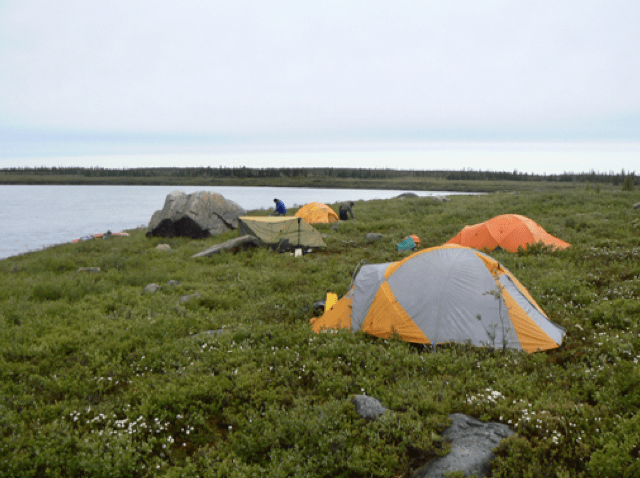Everybody Loves Shrimp Whimsy
It was 48 degrees. The wind-driven rain/sleet-ish mix came at us from the side. After a long day on the Seal River, we were pitching camp on the tundra–when Jeff–Jeff of all people–said he was exhausted, and he’d had it. He was too tired to cook, too tired for Happy Hour with its drink and cigar! He’d be taking a handful of gorp to his tent and turning in for the night. No, no, Noooo, I protested. (I looked forward to Happy Hour—especially that day.) I had a hot dinner planned, I said, easy to prepare, delicious and filling. No trouble at all. I’d do all the cooking and cleanup! Please, just put up the bug tarp and settle under. Jeff was convinced, or at least persuaded, and we enjoyed happy hour under the bug tarp, complete with cigar and fly swatter while dinner rehydrated.

All I had to do was blow on my fingers to warm them, light the stove, cut open the plastic bag and pour its contents into a pot. Add water, bring to a boil, stir, and place the covered pot in an insulated bag (Crockpot carrier) and wait 10 minutes or so. Easy peasy– Happy Hour saved.

And, after Happy Hour, a warm flavorful meal completed the restoration of our good humor. All made possible by dehydrated meals.
I like to use them because they are easy to prepare in the field and require only the fuel necessary to boil water.
The meals are ample, lightweight, and inexpensive—and for me, extend the trip. The time spent at home cooking, dehydrating, and vacuum bagging, is time well spent, in anticipation. Additionally, I have several meals on hand in the freezer, ready to go. They last literally for years. My sister was doing charity work in Africa where it was difficult to obtain meat, but where water and a stove were available. She packed some of my meals in her suitcase and reports that they tasted great in the African backcountry. I had kept them for over three years in the freezer after dehydrating and vacuum bagging.
Virtually any one-pot meal can be dehydrated. Try your favorite. You control the amount of salt, fat, and portion size. You control how spicy the meal is, etc. etc. etc. For me, commercially dried meals are too expensive, taste like cardboard, and are about half of the portion I require.
 All of this culinary control was made possible for me after I obtained a copy of Backpack Gourmet, by Linda Frederick Yaffe (2002), Stackpole Books. ISBN 978- 0-8117-2634-4. The book contains all of the reasons, techniques, recipes, and methods. I can’t recommend it too highly.
All of this culinary control was made possible for me after I obtained a copy of Backpack Gourmet, by Linda Frederick Yaffe (2002), Stackpole Books. ISBN 978- 0-8117-2634-4. The book contains all of the reasons, techniques, recipes, and methods. I can’t recommend it too highly.
Shrimp Whimsy is on page 110. Everybody likes it. Here is the Recipe:
- Cook, then drain in a colander:
14 ounces capellini pasta.
Return the pasta to the pot and set aside.
- Heat a large skillet over medium-low heat. Add
1 tablespoon sesame oil.
When the oil is hot, add and sauté for 1 minute:
3 cloves garlic, 3 scallions, minced.
- Add:
28 ounces canned crushed tomatoes;
8 ounces uncooked shrimp, shelled and deveined, finely chopped;
10 edible-podded (sugar or snap) peas, diced;
20 ounces canned crushed pineapple;
1 tablespoon minced fresh ginger;
1/2 teaspoon salt
1/4 teaspoon cayenne pepper
Bring to a boil; then reduce heat and simmer for 3 minutes.
- Add the sauce to the pasta in the pot and stir.
- Spread on covered dehydrator trays and dehydrate for 6 hours at 145 degrees.
- To rehydrate, cover with water just above level of food in the [pot, boil, stir, and serve.
In addition to the recipes and knowledge contained in that book, I would add:
Sometimes, chicken rehydrates to hard pebbles. I have found that pressure-cooked chicken doesn’t do that—it rehydrates fine. So, where a recipe in the book calls for diced fresh chicken, I will substitute an equal amount of diced canned chicken (which has been pressure cooked in the canning).
Ground beef rehydrates wonderfully.
I usually carry a dried pound or two on trips to add to any meal, as the spirit moves. To dry it, first choose hamburger with a low fat content (fat doesn’t dry well). Brown the hamburger. Then, place it in a strainer and pour boiling water over it to strip off any clinging droplets of fat before drying. Spread on covered dehydrator trays and dehydrate.
Here is a recipe for a Sweet Corn Relish that, although labor-intensive to make at home, is excellent as a side dish with fish and easy to make in camp:
In a large pot, mix:
12 ears fresh Sweet corn, (corn shucked off the cob);
12 ripe tomatoes, peeled & seeded,
4 bell peppers (2 green, 2 red);
1 cucumber, all diced same size as the corn.
Add,
1 C sugar,
1 C Cider vinegar,
1⁄2 C water, 2 T salt,
1⁄2 t pepper,
1⁄2 t turmeric,
1 1⁄2 t mustard seed to the pot.
Cover and simmer for 45 minutes, stirring occasionally.
Spread on covered dehydrator trays and dehydrate at 135° for 8 hours. Redistribute on the trays and dehydrate for another 8 hours (The large sugar content requires a lot of dehydration).
To rehydrate, cover with water just above food level in the pot, boil, stir, and serve.
This White Chicken Chili is a big hit and dehydrates well:
4 C shredded cooked chicken;
1⁄2 stick butter;
1 large onion, chopped;
1 green pepper and 1 red bell pepper, chopped;
4 C chicken broth (2 C if dehydrating);
3 cans Northern beans;
1 can chopped tomatoes;
1 can green chilies;
1 C sweet corn;
1⁄2 T chili powder;
1⁄2 T ground cumin;
1⁄2 T hot pepper sauce;
1⁄2 t white pepper.
Sauté onions and peppers in the butter. Combine broth, chicken, onions, peppers, corn and spices in a large pot on medium heat. Drain juice from tomatoes and chilies and add. Add 2 cans of beans. Puree third can with its liquid and pour into pot.
Bring all to a boil, and simmer for 15 minutes on reduced heat.
Spread on covered dehydrator trays and dehydrate.
To rehydrate, cover with water 1” above the level of the food in the pot, boil, stir, and serve with: 1 1⁄2 C (6 ounces) Monterey Jack Cheese, dollop of sour cream, and chopped fresh cilantro.

This photo is not of Shrimp Whimsy but of Corn Bread in a Bag.
(It’s not dehydrated, but it is very entertaining in a bug tent on the tundra. Also, this is not in the book.)
At Home:
Combine, in a small oven bag:
3/4 C cornbread mix (1/2 of the package)
2 t powdered eggs
1 T powdered milk
In the Bug Tent:
Add 1/4 C water to the bag. Mix well and close bag leaving a little air inside. Tie it shut, using the tie that comes with the bag. Press the batter-filled bag into a round shape the size of the pot. Place the bag in a pot with about 1 1/2 inches of boiling water, cover and boil for about 10 minutes at medium heat. The water should be boiling harder than a simmer, but less than a rolling boil. Remove from the heat and let stand for 3 minutes; cut the bag to release the steam.
Results in a “loaf” – 1 1/4 inches high and 5 1/2 inches in diameter.
Next morning, all was well on the tundra.
– Submitted by David Middlecamp, all content and photographs copyright the author.













Awesome article and thanks for the heads up on the book. I enjoy making my own meals and this book looks excellent – love the north face tent in the photo – I have one just like it. Canoe on!!
Really Great TO Read this article and special thanks for the mentions of further writes. I love reading stuff like this with such mesmerizing images. I am really fond of canoeing now and looking for canoes. One more thing can you please suggest me some good canoes as I had been writing some stuff on it.